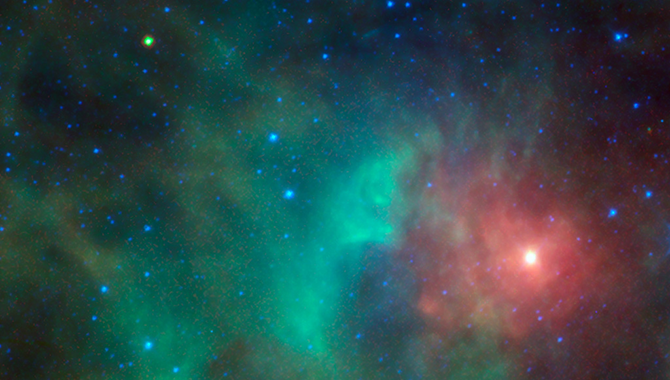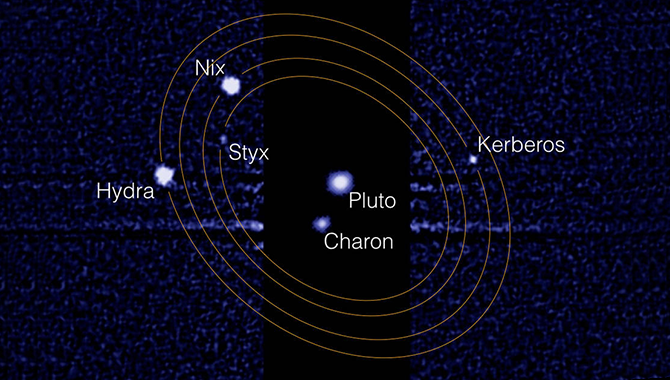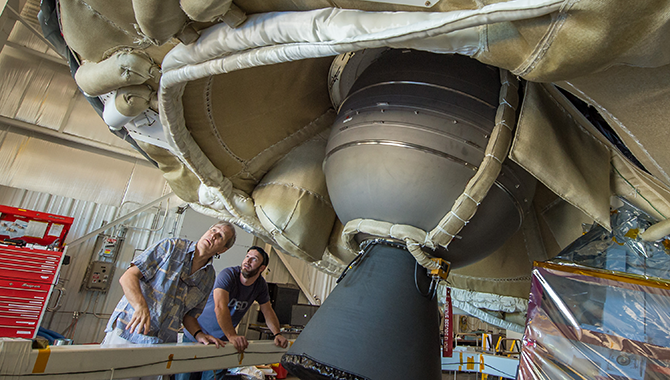
The vivid green dot in the upper left portion of this image, captured by NEOWISE in 2013, is a potentially hazardous near-Earth asteroid known as 1998 KN3. The asteroid is nearly three-quarters of a mile in diameter.
Photo Credit: NASA/JPL-Caltech
In 2013, NASA repurposed a non-operational spacecraft as an asteroid hunter. That mission now helps protect Earth—while contributing to the journey toward Mars.
The Wide-field Infrared Survey Explorer (WISE), a space telescope launched in December 2009, spent a year performing a detailed survey of the entire sky. Findings from the survey have engaged scientists since the first all-sky data release in early 2012, which identified millions of black holes while uncovering both far-flung galaxies and near-Earth comets. Data from WISE revealed a new class of objects called extremely luminous infrared galaxies (ELIRGs), and just last month identified the most luminous galaxy in the universe.
WISE was shut down in February 2011 when it ran out of the cryogenic coolant that kept its telescope and infrared detectors cold. Two of its four instruments continued to work without the coolant, so the spacecraft was revived briefly for a new mission: Near-Earth Object Wide-field Infrared Survey Explorer (NEOWISE). Unlike WISE, NEOWISE had a specific focus on asteroids and comets. But the mission ended after four months and the spacecraft was put into hibernation.
NEOWISE was reactivated in December 2013. At the time, NASA was looking for additional ways to characterize potentially hazardous near-Earth objects (NEOs), and reviving a dormant spacecraft to accomplish this goal was an efficient use of existing resources. NEOWISE detects and characterizes objects with the potential to intersect Earth’s orbit and potentially present a hazard to the planet. In addition, it observes and characterizes asteroids and comets in the main asteroid belt between Mars and Jupiter. Findings from NEOWISE may also be used to help identify an appropriate asteroid for removal to lunar orbit as part of the agency’s Asteroid Redirect Mission (ARM). ARM is an important element in the agency’s planned path toward the red planet.
NEOWISE spots asteroids by picking up their heat signatures. This not only allows the project to pinpoint the location of asteroids, but its infrared technology can better assess the size of objects than visible-light telescopes.
To accomplish its goals, NEOWISE uses the WISE spacecraft in the same operational mode as the original mission but makes independent observations of the sky. The spacecraft still lacks the solid hydrogen used for its cryogenic cooler, but the NEOWISE team found a way to cool the telescope and infrared detectors sufficiently by pointing them in a specific direction.
“We’re still able to keep pretty cold if just we don’t look at the earth,” Amy Mainzer, principal investigator for NEOWISE, said during a conversation with Mat Kaplan of the Planetary Society. “As long as we keep looking at deep space, we are able to radiate a lot of the heat away, out of our telescope. And that’s important because these are infrared wavelengths. We’re looking for heat signatures from asteroids. It wouldn’t work so well if our own telescope was hot. That would be like trying to look at the stars during broad daylight. It just doesn’t work.”
During the first year of its extended mission, NEOWISE provided infrared measurements of over 10,000 celestial objects, and by early 2015 had detected 12,000 small solar system objects. Nearly 40 of these are NEOs, with 8 characterized as potentially hazardous asteroids (PHAs). The mission has also detected three new comets and identified the brightest comet in Earth’s sky as of early 2015, known as Lovejoy (Comet C/2014 Q2).
NEOWISE conducts a complete survey of the entire sky every six months. Every year, the team releases the latest findings to the public in order to engage the broader scientific community in identifying small solar system objects. The March 2015 NEOWISE data release featured all of the observations from the mission in its first year.
Observations are made at dawn and dusk, which allows NEOWISE to see objects moving toward the earth from the sun. In this way, the mission offers a different perspective—and more information—than Earth-based telescopes, which observe the night sky.
The current mission is slated to last three years, from late 2013 through 2016. Like WISE, the project is managed and operated by the Jet Propulsion Laboratory (JPL) for NASA’s Science Mission Directorate.
View a video depicting the progression of NEOWISE observations between December 2013 and December 2014.
Learn more about the WISE discovery of the most luminous galaxy in the universe.









